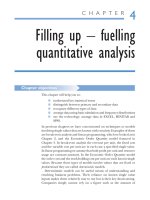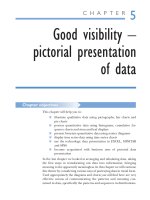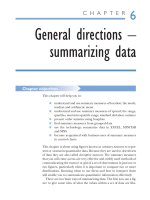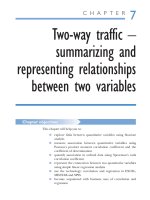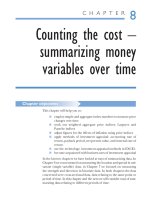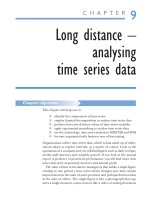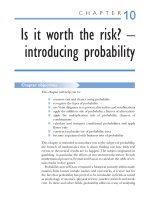Test bank quantitative methods for business 13e ch1
Bạn đang xem bản rút gọn của tài liệu. Xem và tải ngay bản đầy đủ của tài liệu tại đây (217.66 KB, 47 trang )
Chapter 1 - Introduction
True / False
1. The process of decision making is more limited than that of problem solving.
a. True
b. Fals
e
ANSWER: True
POINTS: 1
TOPICS: Problem solving and decision making
2. The terms 'stochastic' and 'deterministic' have the same meaning in quantitative analysis.
a. True
b. Fals
e
ANSWER: False
POINTS: 1
Cengage Learning Testing, Powered by Cognero
Page 1
Chapter 1 - Introduction
TOPICS: Model development
3. The volume that results in marginal revenue equaling marginal cost is called the break-even point.
a. True
b. Fals
e
ANSWER: False
POINTS: 1
TOPICS: Problem solving and decision making
4. Problem solving encompasses both the identification of a problem and the action to resolve it.
a. True
b. Fals
e
ANSWER: True
POINTS: 1
Cengage Learning Testing, Powered by Cognero
Page 2
Chapter 1 - Introduction
TOPICS: Problem solving and decision making
5. The decision making process includes implementation and evaluation of the decision.
a. True
b. Fals
e
ANSWER: False
POINTS: 1
TOPICS: Problem solving and decision making
6. The most successful quantitative analysis will separate the analyst from the managerial team until after the problem is
fully structured.
a. True
b. Fals
e
ANSWER: False
POINTS: 1
Cengage Learning Testing, Powered by Cognero
Page 3
Chapter 1 - Introduction
TOPICS: Quantitative analysis
7. The value of any model is that it enables the user to make inferences about the real situation.
a. True
b. Fals
e
ANSWER: True
POINTS: 1
TOPICS: Model development
8. Uncontrollable inputs are the decision variables for a model.
a. True
b. Fals
e
ANSWER: False
Cengage Learning Testing, Powered by Cognero
Page 4
Chapter 1 - Introduction
POINTS: 1
TOPICS: Model development
9. The feasible solution is the best solution possible for a mathematical model.
a. True
b. Fals
e
ANSWER: False
POINTS: 1
TOPICS: Model solution
10. A company seeks to maximize profit subject to limited availability of man-hours. Man-hours is a controllable input.
a. True
b. Fals
e
ANSWER: False
Cengage Learning Testing, Powered by Cognero
Page 5
Chapter 1 - Introduction
POINTS: 1
TOPICS: Model development
11. Frederick Taylor is credited with forming the first MS/OR interdisciplinary teams in the 1940's.
a. True
b. Fals
e
ANSWER: False
POINTS: 1
TOPICS: Introduction
12. To find the choice that provides the highest profit and the fewest employees, apply a single-criterion decision process.
a. True
b. Fals
e
ANSWER: False
Cengage Learning Testing, Powered by Cognero
Page 6
Chapter 1 - Introduction
POINTS: 1
TOPICS: Problem solving and decision making
13. The most critical component in determining the success or failure of any quantitative approach to decision making is
problem definition.
a. True
b. Fals
e
ANSWER: True
POINTS: 1
TOPICS: Quantitative analysis
14. The first step in the decision making process is to identify the problem.
a. True
b. Fals
e
ANSWER: True
Cengage Learning Testing, Powered by Cognero
Page 7
Chapter 1 - Introduction
POINTS: 1
TOPICS: Introduction
15. All uncontrollable inputs or data must be specified before we can analyze the model and recommend a decision or
solution for the problem.
a. True
b. Fals
e
ANSWER: True
POINTS: 1
TOPICS: Quantitative analysis
16. In quantitative analysis, the optimal solution is the mathematically-best solution.
a. True
b. Fals
e
Cengage Learning Testing, Powered by Cognero
Page 8
Chapter 1 - Introduction
ANSWER: True
POINTS: 1
TOPICS: Quantitative analysis
17. If you are deciding to buy either machine A, B, or C with the objective of minimizing the sum of labor, material and
utility costs, you are dealing with a single-criterion decision.
a. True
b. Fals
e
ANSWER: True
POINTS: 1
TOPICS: Problem solving and decision making
18. Model development should be left to quantitative analysts; the model user's involvement should begin at the
implementation stage.
a. True
b. Fals
Cengage Learning Testing, Powered by Cognero
Page 9
Chapter 1 - Introduction
e
ANSWER: False
POINTS: 1
TOPICS: Problem solving and decision making
19. A feasible solution is one that satisfies at least one of the constraints in the problem.
a. True
b. Fals
e
ANSWER: False
POINTS: 1
TOPICS: Model solution
20. A toy train layout designed to represent an actual railyard is an example of an analog model.
a. True
Cengage Learning Testing, Powered by Cognero
Page 10
Chapter 1 - Introduction
b. Fals
e
ANSWER: False
POINTS: 1
TOPICS: Model development
Multiple Choice
21. The field of management science
a. concentrates on the use of quantitative methods to assist in decision making.
b. approaches decision making rationally, with techniques based on the scientific
method.
c. is another name for decision science and for operations research.
d. each of these choices are true.
ANSWER: d
POINTS: 1
Cengage Learning Testing, Powered by Cognero
Page 11
Chapter 1 - Introduction
TOPICS: Introduction
22. Identification and definition of a problem
a. cannot be done until alternatives are proposed.
b. is the first step of decision making.
c. is the final step of problem solving.
d. requires consideration of multiple criteria.
ANSWER: b
POINTS: 1
TOPICS: Problem solving and decision making
23. Decision alternatives
a. should be identified before decision criteria are established.
b. are limited to quantitative solutions
c. are evaluated as a part of the problem definition stage.
Cengage Learning Testing, Powered by Cognero
Page 12
Chapter 1 - Introduction
d. are best generated by brain-storming.
ANSWER: a
POINTS: 1
TOPICS: Problem solving and decision making
24. Decision criteria
a. are the choices faced by the decision maker.
b. are the problems faced by the decision maker.
c. are the ways to evaluate the choices faced by the decision maker.
d. must be unique for a problem.
ANSWER: c
POINTS: 1
TOPICS: Problem solving and decision making
Cengage Learning Testing, Powered by Cognero
Page 13
Chapter 1 - Introduction
25. In a multicriteria decision problem
a. it is impossible to select a single decision alternative.
b. the decision maker must evaluate each alternative with respect to each criterion.
c. successive decisions must be made over time.
d. each of these choices are true.
ANSWER: b
POINTS: 1
TOPICS: Problem solving and decision making
26. The quantitative analysis approach requires
a. the manager's prior experience with a similar problem.
b. a relatively uncomplicated problem.
c. mathematical expressions for the relationships.
ANSWER: c
Cengage Learning Testing, Powered by Cognero
Page 14
Chapter 1 - Introduction
POINTS: 1
TOPICS: Quantitative analysis and decision making
27. A physical model that does not have the same physical appearance as the object being modeled is
a. an analog model.
b. an iconic model.
c. a mathematical model.
d. a qualitative model.
ANSWER: a
POINTS: 1
TOPICS: Model development
28. Inputs to a quantitative model
a. are a trivial part of the problem solving process.
b. are uncertain for a stochastic model.
Cengage Learning Testing, Powered by Cognero
Page 15
Chapter 1 - Introduction
c. are uncontrollable for the decision variables.
d. must all be deterministic if the problem is to have a solution.
ANSWER: b
POINTS: 1
TOPICS: Model development
29. When the value of the output cannot be determined even if the value of the controllable input is known, the model is
a. analog.
b. digital.
c. stochastic.
d. deterministic.
ANSWER: c
POINTS: 1
Cengage Learning Testing, Powered by Cognero
Page 16
Chapter 1 - Introduction
TOPICS: Model development
30. The volume that results in total revenue being equal to total cost is the
a. break-even point.
b. marginal volume.
c. marginal cost.
d. profit mix.
ANSWER: a
POINTS: 1
TOPICS: Break-even analysis
31. Management science and operations research both involve
a. qualitative managerial skills.
b. quantitative approaches to decision making.
c. operational management skills.
Cengage Learning Testing, Powered by Cognero
Page 17
Chapter 1 - Introduction
d. scientific research as opposed to applications.
ANSWER: b
POINTS: 1
TOPICS: Introduction
32. George Dantzig is important in the history of management science because he developed
a. the scientific management revolution.
b. World War II operations research teams.
c. the simplex method for linear programming.
d. powerful digital computers.
ANSWER: c
POINTS: 1
TOPICS: Introduction
Cengage Learning Testing, Powered by Cognero
Page 18
Chapter 1 - Introduction
33. The first step in problem solving is
a. determination of the correct analytical solution procedure.
b. definition of decision variables.
c. the identification of a difference between the actual and desired state of affairs.
d. implementation.
ANSWER: c
POINTS: 1
TOPICS: Problem solving and decision making
34. Problem definition
a. includes specific objectives and operating constraints.
b. must occur prior to the quantitative analysis process.
c. must involve the analyst and the user of the results.
d. each of these choices are true.
Cengage Learning Testing, Powered by Cognero
Page 19
Chapter 1 - Introduction
ANSWER: d
POINTS: 1
TOPICS: Quantitative analysis
35. A model that uses a system of symbols to represent a problem is called
a. mathematical.
b. iconic.
c. analog.
d. constrained.
ANSWER: a
POINTS: 1
TOPICS: Model development
36. Which of the following is not one of the commonly used names for the body of knowledge involving quantitative
approaches to decision-making?
Cengage Learning Testing, Powered by Cognero
Page 20
Chapter 1 - Introduction
a. management science
b. business analytics
c. operations research
d. efficiency studies
ANSWER: d
POINTS: 1
TOPICS: Introduction
37. The scientific management revolution of the early 1900s was initiated by
a. James Lingo
b. Herbert Simon
c. Frederic Taylor
d. George Dantzig
ANSWER: c
Cengage Learning Testing, Powered by Cognero
Page 21
Chapter 1 - Introduction
POINTS: 1
38. The decision variables of a model are also known as the
a. uncontrollable output
b. controllable inputs
c. environmental factors
d. projected results
ANSWER: b
POINTS: 1
39. A physical model that has the same physical appearance as the object being modeled is
a. an analog model
b. an iconic model
c. a mathematical model
d. a deterministic model
Cengage Learning Testing, Powered by Cognero
Page 22
Chapter 1 - Introduction
ANSWER: b
POINTS: 1
40. When production volume exceeds the breakeven point, we can expected
a. fixed cost to decrease
b. a loss
c. marginal revenue to decrease
d. a profit
ANSWER: d
POINTS: 1
Subjective Short Answer
41. A snack food manufacturer buys corn for tortilla chips from two cooperatives, one in Iowa and one in Illinois. The
price per unit of the Iowa corn is $6.00 and the price per unit of the Illinois corn is $5.50.
Cengage Learning Testing, Powered by Cognero
Page 23
Chapter 1 - Introduction
a.
Define variables that would tell how many units to purchase from each source.
b.
Develop an objective function that would minimize the total cost.
c.
The manufacturer needs at least 12000 units of corn. The Iowa cooperative can supply up to
8000 units, and the Illinois cooperative can supply at least 6000 units. Develop constraints
for these conditions.
ANSWER
:
a.
Let x1 = the number of units from Iowa
Let x2 = the number of units from Illinois
b.
Min 6x1 + 5.5x2
c.
x1 + x 2 ≥ 12000
x1 ≥ 8000
x1 ≥ 6000
POINTS: 1
TOPICS: Model development
42. The relationship d = 5000 − 25p describes what happens to demand (d) as price (p) varies. Here, price can vary
Cengage Learning Testing, Powered by Cognero
Page 24
Chapter 1 - Introduction
between $10 and $50.
a.
How many units can be sold at the $10 price? How many can be sold at the $50 price?
b.
Model the expression for total revenue.
c.
Consider prices of $20, $30, and $40. Which of these three price alternative will maximize
total revenue? What are the values for demand and revenue at this price?
ANSWER
:
a.
For p = 10, d = 4750
For p = 50, d = 3750
b.
TR = p(5000 − 25p)
c.
For p = 20, d = 4500, TR = $90,000
For p = 30, d = 4250, TR = $127,500
For p = 40, d = 4000, TR = $160,000 (maximum total revenue)
POINTS: 1
TOPICS: Model development
43. There is a fixed cost of $50,000 to start a production process. Once the process has begun, the variable cost per unit is
Cengage Learning Testing, Powered by Cognero
Page 25



